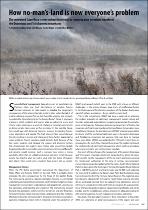 ResearchSpace
ResearchSpace
How no-man’s-land is now everyone’s problem: the renowned Cape flora is everywhere in retreat as runaway pine invasions transform the Outeniqua and Tsitsikamma mountains
JavaScript is disabled for your browser. Some features of this site may not work without it.
- ResearchSpace
- →
- Research Publications/Outputs
- →
- Journal Articles
- →
- View Item
| dc.contributor.author |
Cowling, R

|
|
| dc.contributor.author |
Van Wilgen, BW

|
|
| dc.contributor.author |
Kraaij, T

|
|
| dc.contributor.author |
Britton, J

|
|
| dc.date.accessioned | 2009-12-03T13:35:41Z | |
| dc.date.available | 2009-12-03T13:35:41Z | |
| dc.date.issued | 2009-09 | |
| dc.identifier.citation | Cowling, R, Van Wilgen, BW, Kraaij, T and Britton, J. 2009. How no-man’s-land is now everyone’s problem: the renowned Cape flora is everywhere in retreat as runaway pine invasions transform the Outeniqua and Tsitsikamma mountains. Veld & Flora, Vol.95(3), pp 147-149 | en |
| dc.identifier.issn | 0042-3203 | |
| dc.identifier.uri | http://hdl.handle.net/10204/3794 | |
| dc.description | Copyright: 2009 Botanical Society of South Africa | en |
| dc.description.abstract | Successful land management depends in part on good planning. Planners often use brief descriptions of possible futures (termed scenarios) to help people to visualize the longer-term consequences of the actions they take (or fail to take) today. Our tale is of a rather sobering scenario that we feel should be urgently and seriously considered by those planning for the Garden Route’s future. It envisages a future in which residents and tourists alike are subject to severe and chronic water rationing as a result of a failure of mountain catchments to deliver ample, clean water as they do today. In this possible future, fires would rage with abnormal intensity, seriously threatening homes, crops, plantations and people. The high-intensity fires would damage the soil, resulting in erosion and silting up of dams, further exacerbating water problems. Tourist numbers would dwindle, both because of the dire water situation and because the unique and attractive fynbos that characterizes the region’s many hiking trails would have largely disappeared under invasive alien pines. Economic activity would flounder and poverty would increase. Such a scenario now seems a strong possibility rather than an unlikely and distant outcome, simply because society has failed to plan for, and to deal with, the threat of invasive alien plants. How could such a situation have arisen? Let us explain. | en |
| dc.language.iso | en | en |
| dc.publisher | Botanical Society of South Africa | en |
| dc.subject | Cape Floral Region | en |
| dc.subject | Cape flora | en |
| dc.subject | Pine invasion | en |
| dc.subject | Fynbos | en |
| dc.subject | Outeniqua mountains | en |
| dc.subject | Tsitsikamma mountains | en |
| dc.title | How no-man’s-land is now everyone’s problem: the renowned Cape flora is everywhere in retreat as runaway pine invasions transform the Outeniqua and Tsitsikamma mountains | en |
| dc.type | Article | en |
| dc.identifier.apacitation | Cowling, R., Van Wilgen, B., Kraaij, T., & Britton, J. (2009). How no-man’s-land is now everyone’s problem: the renowned Cape flora is everywhere in retreat as runaway pine invasions transform the Outeniqua and Tsitsikamma mountains. http://hdl.handle.net/10204/3794 | en_ZA |
| dc.identifier.chicagocitation | Cowling, R, BW Van Wilgen, T Kraaij, and J Britton "How no-man’s-land is now everyone’s problem: the renowned Cape flora is everywhere in retreat as runaway pine invasions transform the Outeniqua and Tsitsikamma mountains." (2009) http://hdl.handle.net/10204/3794 | en_ZA |
| dc.identifier.vancouvercitation | Cowling R, Van Wilgen B, Kraaij T, Britton J. How no-man’s-land is now everyone’s problem: the renowned Cape flora is everywhere in retreat as runaway pine invasions transform the Outeniqua and Tsitsikamma mountains. 2009; http://hdl.handle.net/10204/3794. | en_ZA |
| dc.identifier.ris | TY - Article AU - Cowling, R AU - Van Wilgen, BW AU - Kraaij, T AU - Britton, J AB - Successful land management depends in part on good planning. Planners often use brief descriptions of possible futures (termed scenarios) to help people to visualize the longer-term consequences of the actions they take (or fail to take) today. Our tale is of a rather sobering scenario that we feel should be urgently and seriously considered by those planning for the Garden Route’s future. It envisages a future in which residents and tourists alike are subject to severe and chronic water rationing as a result of a failure of mountain catchments to deliver ample, clean water as they do today. In this possible future, fires would rage with abnormal intensity, seriously threatening homes, crops, plantations and people. The high-intensity fires would damage the soil, resulting in erosion and silting up of dams, further exacerbating water problems. Tourist numbers would dwindle, both because of the dire water situation and because the unique and attractive fynbos that characterizes the region’s many hiking trails would have largely disappeared under invasive alien pines. Economic activity would flounder and poverty would increase. Such a scenario now seems a strong possibility rather than an unlikely and distant outcome, simply because society has failed to plan for, and to deal with, the threat of invasive alien plants. How could such a situation have arisen? Let us explain. DA - 2009-09 DB - ResearchSpace DP - CSIR KW - Cape Floral Region KW - Cape flora KW - Pine invasion KW - Fynbos KW - Outeniqua mountains KW - Tsitsikamma mountains LK - https://researchspace.csir.co.za PY - 2009 SM - 0042-3203 T1 - How no-man’s-land is now everyone’s problem: the renowned Cape flora is everywhere in retreat as runaway pine invasions transform the Outeniqua and Tsitsikamma mountains TI - How no-man’s-land is now everyone’s problem: the renowned Cape flora is everywhere in retreat as runaway pine invasions transform the Outeniqua and Tsitsikamma mountains UR - http://hdl.handle.net/10204/3794 ER - | en_ZA |





